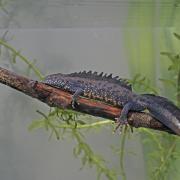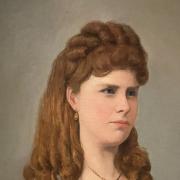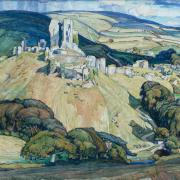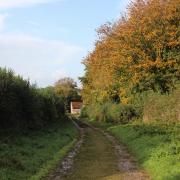From Black Beauty illustrations to being feted by the Royal Academy, the works of one of Britain’s finest equestrian artists are showcased in an exhibition held in the town of her birth
A rare combination of prodigious talent, intuitive understanding and carefully honed skill made equestrian artist Lucy Kemp-Welch one of the finest painters of her generation.
Sadly, although her star did indeed shine brightly for many years, history was not on her side. Born into a well-to-do Bournemouth family in 1869, she lived through an era marked by war and burgeoning modernity. It was a world dominated by men. Making an impact as a female artist was far from easy. Socially and politically the cards were stacked against her.

Kemp-Welch found fame while still in her twenties and exhibited her first painting, Gypsy Horse Drovers, at the prestigious Royal Academy (RA) in London when she was just 26 years old. But it was two years later when her huge painting Colt Hunting in the New Forest was exhibited at the Royal Academy’s 1897 Summer Exhibition that the name Lucy Kemp-Welch really started to get noticed by the art establishment. Amazed by its size, power and detail, critics predicted great things for this extraordinary young woman.
Kemp-Welch would hang many more notable paintings at the RA over the coming decades. She also enjoyed a certain level of celebrity as the illustrator of the 1915 edition of Anna Sewell’s best-selling novel Black Beauty.
However, suggestions that she was on course to become the first woman since the mid-18th century to be officially admitted as a Royal Academician never came to fruition. By the time of her death in the late 1950s the name of Lucy Kemp-Welch was already being sidelined.

Thankfully much has been done in recent years to restore her reputation as one of the towering, if largely forgotten, artistic talents of the 20th century. This includes a major retrospective of her work at the Russell-Cotes Art Gallery and Museum in Bournemouth.
It could not be a more appropriate location because it not only brings the work of Kemp-Welch back to the town of her birth, but also the building on East Cliff was once the home of art collector and philanthropist Sir Merton Russell-Cotes who was one of her early supporters.
This wide-ranging and impressive exhibition, In Her Own Voice: The Art of Lucy Kemp-Welch (1869–1958) runs in Bournemouth until October 1st and then moves to the National Horse Racing Museum in Newmarket until January 2024. Curated by art historian David Boyd Haycock, the exhibition focuses on key works and moments in Kemp-Welch’s long and illustrious career.

It explores the early influence of her life on the south coast and childhood trips to the New Forest, famous for its eponymous ponies. It also reveals her unstinting commitment to her art and the teaching of the eccentric but brilliant German-born Hubert von Herkomer whose art school she attended in Bushey, Hertfordshire. Kemp-Welch admired the school so much that when Herkomer retired in 1906, she took it over becoming the first woman to run a British art school for both male and female students.
Herkomer had believed that for Kemp-Welch to capture the real essence of the horses she painted she should spend weeks studying the animals close-up in the woods and fields of the English countryside. She responded with great enthusiasm establishing the lifelong work practices that would produce some truly stunning paintings. Among them was location painting where she would capture scenes of timber hauling or hunting using massive mobile canvases in weather-proof boxes.

As the title of this exhibition suggests, it is the paintings that really do the talking. The sheer power and majesty of works like Burnt Out Fires, showing three working horses returning home across stubble-burnt fields, or the struggle and urgency captured in The Call with horses straining to drag a lifeboat into a furious foaming sea are breathtaking.
Throughout the show, Kemp-Welch’s mastery of colour, light and energy alongside her deep understanding of everything equine from sinew and muscle to the behavioural quirks of the horses she painted is displayed again and again.
There were many intriguing twists and turns in her life and career. For several years she would spend each summer following the famous Sanger’s Circus around the country, painting numerous pictures of their horses. Solidly respectable and widely admired, Kemp-Welch was nonetheless distinctly unconventional.
Though she was, as David Boyd Haycock has noted, neither a suffragette nor a feminist, Kemp-Welch was clearly not prepared to be restricted by her gender. During the First World War she volunteered to go to the front as an official war artist but had to be satisfied with painting the British Army’s training exercises on Salisbury Plain instead.

The war work, including some recruitment posters which can be seen in the exhibition, is a minor diversion and of scant importance besides the quality of her major paintings. Viewed from a contemporary perspective, it seems rather distasteful, drumming up cannon fodder for the carnage of the First World War; although at the time Kemp-Welch would have simply seen it as doing her bit for King and Country. It also helps put her career into some kind of historical context that goes at least some way to explaining why she faded from the public eye by the mid-20th century.
Battered by two world wars and a major recession, it was an age driven by the need to rebuild. Engineering and industry were prime in post-war Britain, and the noble working beasts of Kemp-Welch’s world were being rapidly replaced by a variety of horseless carriages. By the time she reached her final years, her work was simply out of step with the times. Perhaps that point is driven home by the fact that the landmark event on the London art scene in the year that she died, aged 89, was a big Jackson Pollock show. Thankfully we now have an art world where the modernist and traditional can be studied, admired and enjoyed with equal intellectual rigour.

There is much to think about at this Lucy Kemp-Welch exhibition. I hope you will leave the show not only impressed by her astounding paintings, but also newly aware of what an extraordinary individual she was.
In Her Own Voice: The Art of Lucy Kemp-Welch (1869–1958) is at the Russell-Cotes Art Gallery and Museum in Bournemouth until October 1st. russellcotes.com



























